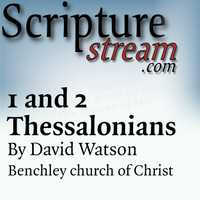-
1 Thessalonians
-
Introduction to the book
-
Probably written about 51 A.D. The writer was Paul.
-
Paul brought the gospel to Thessalonica on his second missionary journey, recorded in Acts 15:36-18:22.
-
Paul left Thessalonica abruptly due to persecution (Acts 17:1-5) and sent Timothy to check on them a short time later (1 Thessalonians 3:1-2). Timothy caught up with Paul in Corinth (Acts 18:1-5) and delivered good news of their “faith and love.”
-
Paul appears to have written these two letters to them soon after Timothy’s return, while Paul was in Corinth (1 Thessalonians 3:6).
-
-
Thessalonica
-
The city of Thessalonica was the most populous city in Macedonia at that time, with roughly 200,000 inhabitants. The city was an important military and commercial port and became the capital of Macedonia in 146 B.C.
-
The modern city of Thessaloniki sits of top of the ruins of the old city of Thessalonica, making excavation difficult.
-
A first century arch, called the Vandar Arch once existed in Thessaloniki. It was torn down in 1867, but an inscription from the arch was preserved in the British Museum. It is notable in that it mentions officials called politarchs, a Greek word that Luke used to designate Thessalonian officials in Acts 17:6. Before this discovery, there had previously been some doubt about Luke’s use of this word since it had not been found in other Greek literature. This find helps illustrate the precision of Luke’s account.
-
-
Imagine you’re a Thessalonians. What’s your reaction to this?
-
1 Thessalonians 1:1-10 – Immediately, there’s a positive, encouraging tone.
-
1 Thessalonians 2:1-20 – Paul reminisces with them about their time together and expresses thanks for them.
-
1 Thessalonians 3:1-13 – They received a good report from Timothy!
-
1 Thessalonians 4:1-18 – “Excel still more.” Looking forward to judgment.
-
1 Thessalonians 5:1-28 – Encouragement for the judgment to come. Final advice.
-
-
DW
October 04, 2020
For further study, see also:
Questions or comments? Join our Discord server for further study.
